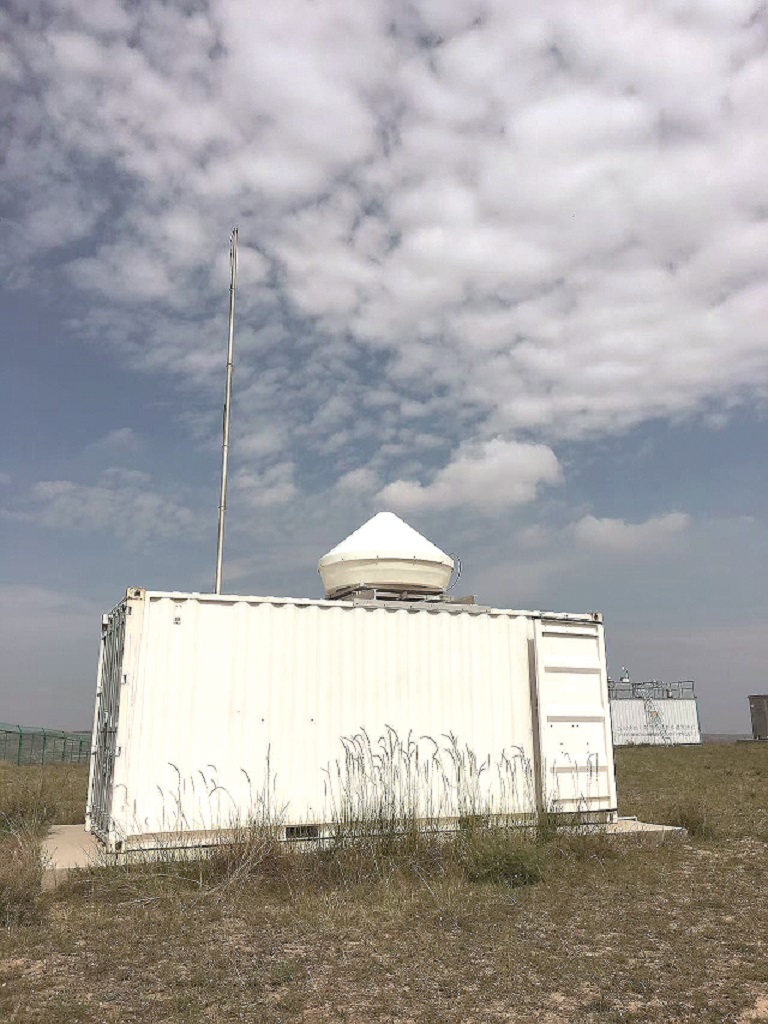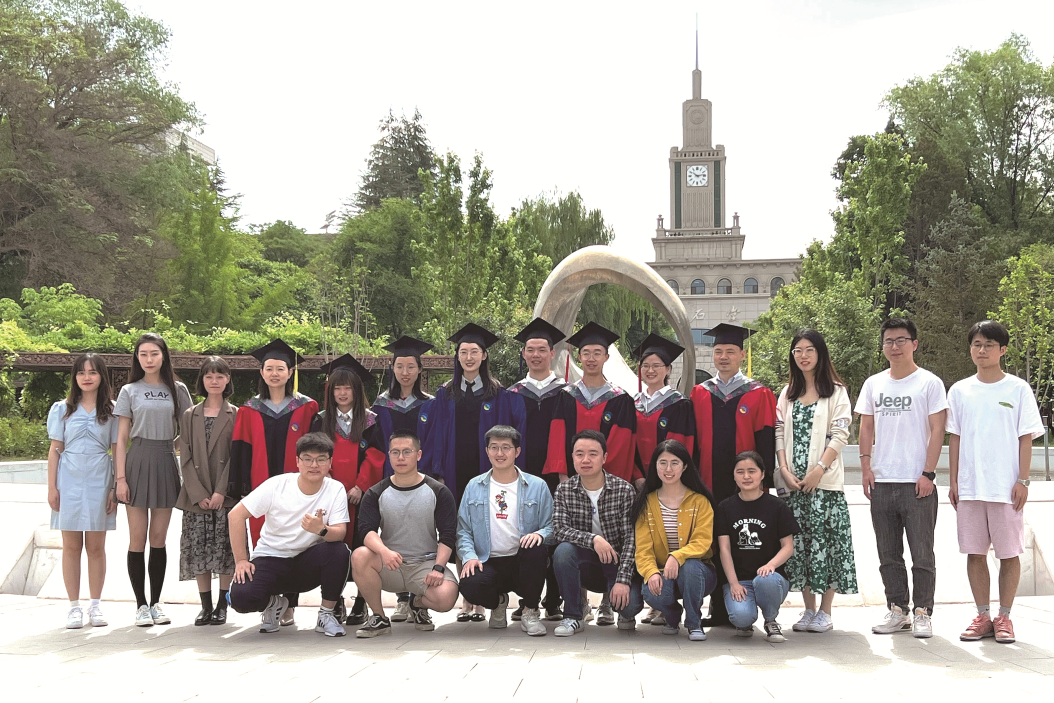
Millimeter wave cloud radar placed at SACOL station in 2013
In the early morning, the Yuzhong campus of Lanzhou University was just beginning to show its light, and Cuiying Mountain was still shrouded in mist. Professor Ge Jinming from the College of Atmospheric Sciences and his doctoral student Du Jiajing, along with a few other students, had already arrived at the foot of Cuiying Mountain, preparing to head towards the semi-arid climate and environment observatory (SACOL) located on the mountaintop. Their day's work began with climbing.
Regardless of scorching heat or bitter cold, such observations have been consistently maintained by the team for over a decade. Their efforts have finally borne fruit, with a new method for cloud and water content inversion based on mass absorption published in the prestigious international journal *IEEE Transactions on Geoscience and Remote Sensing* in 2023, followed by the latest research paper titled "An Accurate Retrieval of Cloud Droplet Effective Ra-dius for Single-Wavelength Cloud Radar" in 2024.
This study breaks through the previous idea of using backscattered signals and empirical methods to obtain cloud characteristics by millimeter-wave cloud radar. Considering that the transmission of electromagnetic waves in clouds is mainly attenuated by water absorption, a new method of effective droplet radius detection and inversion based on adaptive constraint of physical process is proposed."Clouds are one of the most critical factors affecting weather and climate forecasting. Current models still have significant uncertainties in simulating this aspect. A key role of millimeter-wave cloud radar is to provide high-resolution observations of vertical cloud property profiles, which can be used to study cloud physics processes, thereby comparing and improving model simulations. One of our main research directions is to use advanced cloud radars for field observations of clouds, analyzing and understanding cloud formation and dissipation, and accurately identifying and reconstructing both macroscopic and microscopic cloud properties to better understand cloud physics processes," Professor Ge Jinming explained.

The station was installed in 2013
Establish a site to detect the echo signal of cloud droplet particles
In 2013, the college introduced KAZR, the most advanced millimeter-wave radar in the world at that time. This container equipment with a "big head" was hoisted to a pre-prepared foundation platform on Cuiying Mountain to prevent subsidence, thus establishing the earliest cloud radar observation point in northwest China.
The variation of atmospheric elements in the horizontal direction is usually much smaller than that in the vertical direction. Choosing an appropriate site can represent the overall characteristics of a certain area. Cuiying Mountain is a very representative site; conducting observations here plays a crucial role in understanding the characteristics of atmospheric changes in Northwest China, said Ge Jinming. "Cuiying Mountain is located in the mid-latitudes of Northwest China, where the four seasons are distinct, and different seasons are controlled by different weather processes, leading to extremely rich cloud development. During the cold season, frontal and cyclonic activities form large-scale stratiform clouds. In the warm season, convection and the extension of the tropopause result in convective precipitation clouds and higher-positioned ice clouds. Combined with the unique dust aerosols in Northwest China, this site is an ideal location for studying various types of clouds and their interactions with aerosols."
The KAZR millimeter-wave cloud radar sends out an electromagnetic pulse into the sky every four seconds, simultaneously recording the echo signals of water condensates in the atmosphere. This high-resolution detection has been repeated day after day, and since its inception on Cuiying Mountain, it has continued for over a decade, accumulating vast amounts of data for subsequent research. "I had just started my career, and the research on cloud radar was completely unfamiliar and novel compared to my studies during my doctoral period. Faced with expensive and advanced equipment, and the significant scientific questions it could address, I found it quite appealing at the time." However, exploring unknown territories is still quite challenging. From the radar work in 2013 to the publication of the first related research paper, it took nearly five years. This long and arduous process is hard to imagine today." Driven by a thirst for knowledge and curiosity about exploration, coupled with the demands of later work, Ge Jinming continuously explored from scratch, gradually forging his own path.
With the equipment and the annual intake of master's and doctoral students, a young cloud radar research team gradually formed. The winter at Cuiying Mountain is harsh with biting cold winds, while the summer is scorching under the blazing sun. Ge Jinming leads his students to climb from the foot of the mountain to the observation station time and again to maintain the radar system and collect observational data, continuously learning, familiarizing themselves with, and cherishing this equipment. Years of study and work have deeply impressed every member of the team with the development philosophy proposed by senior figures like Academician Huang Jianping of the college: "turning geographical disadvantages into research advantages." "The radar I saw in reality was vastly different from what I had imagined; I always thought it was just an exposed, solitary' big pot. 'It wasn't until we arrived at the observation station that we discovered KAZR not only has a conical radar antenna protection cover but also numerous transmission, reception, control, storage, and cooling units neatly arranged in containers, forming the entire complex system," Du Jiajing said.
The radar has several major systems that operate in an orderly manner under the monitoring and coordination of computers, but some of these still require personnel for regular maintenance to ensure the equipment functions properly. Du Jiajing explained, "The cooling system of the radar needs to be inspected and coolant added every month to ensure the normal operation of the electromagnetic wave emission system and stable thermal noise; data storage from the radar must be backed up in a timely manner to enable continuous acquisition and preservation of observation results; radar pulses need to be periodically compressed and modulated to ensure concentrated transmission energy; the antenna dome needs to be cleaned of dust to reduce signal attenuation, but it must also be handled with great care to protect the hydrophobic nano-coating on its surface. All these maintenance tasks aim to obtain high-quality data, which allows us to use the data for research work smoothly and confidently."

Maintenance of radar antenna reference level
Break through the problem and develop a new method of low cloud characteristic inversion
In 2019, Du Jiajing joined Professor Ge Jinming's research group. Prior to this, the group had conducted extensive research on quality control of raw radar data, proposing advanced algorithms such as bilateral filtering. Building on this foundation, Du Jiajing further explored the microphysical properties of low clouds, including liquid water content in clouds, effective droplet radius, and cloud optical depth.
"Developing a new method to invert cloud microphysical properties based on existing radar data was undoubtedly a huge challenge for me when I first joined the research group. However, I soon realized that my senior colleagues were very familiar with cloud radar principles and data. Since I have a keen interest in atmospheric radiation, I began to learn from everyone." Du Jiajing said modestly, "At the beginning, regarding the construction of algorithms, the teacher emphasized the advantage of using radar in the Rayleigh scattering domain to avoid assumptions about particle spectra. However, there was no clear path on how to apply this in radar observations."
Previous cloud water content inversion algorithms were straightforward, primarily using the definition of radar reflectivity factors and cloud water content. They derived empirical coefficients for their relationship through aircraft observations and assumed cloud droplet size distribution functions in model simulations to determine cloud water content. However, these empirical relationships are constrained by various factors such as cloud type, meteorological conditions, and instrument calibration, often resulting in errors exceeding 100%. Therefore, it is necessary to explore new methods that do not rely on empirical coefficients or assumptions about cloud droplet size distributions to reduce this error.
"The construction of the new method involves both conceptual design and extensive mathematical derivations. At the beginning, I had no confidence at all about how to complete it. Any work I started would encounter unexpected problems, so I sought advice from my teacher," Du Jiajing said. "The teacher, instead of being disappointed by the cumbersome formulas and highly inaccurate diagrams I wrote on my draft paper, patiently verified the accuracy of the formulas, analyzed and organized the logical flow of ideas, and proposed solutions to each stuck problem. The development of the algorithm gradually accelerated." Under Professor Ge Jinming's guidance and encouragement, Du Jiajing ultimately completed a new algorithm for cloud radar quality absorption inversion of cloud water content, which is logically clear and physically accurate.

Professor Ge Jinming led the team members to understand and familiarize themselves with the observation instruments of the Semi-arid Climate and Environment Observatory (SACOL station)
Continue to follow up and comprehensively analyze the characteristics of different types of clouds
"This new algorithm obtains cloud water content through coordinated adaptive inversion of physical quantities, achieving inversion using single-wavelength cloud radar without relying on the spectral distribution function of cloud droplets and empirical coefficients. This is the uniqueness of the algorithm," Du Jiajing explained. "During the pandemic, my teacher mentioned in an online meeting that we could further develop methods for the inversion of effective cloud droplet radius based on the mathematical definitions of physical quantities, building upon the inversion of cloud water content. The teacher also instructed me to focus on the intrinsic relationships between physical quantities. With previous experience in algorithm development, the work on effective cloud droplet radius proceeded smoothly after conducting sensitivity analysis of parameters."
On this basis, the team also introduced the calculation of cloud optical thickness, and compared the inversion results with the products provided by in-situ aircraft detection, satellite microwave radiometer and medium resolution imaging spectrometer. It was found that the consistency between the inversion of cloud microphysical properties by the new algorithm and the observation results of passive sensors was greatly improved.
In 2024, Du Jiajing published the relevant research as the first author in IEEE Transactions on Geoscience and Remote Sensing (SCI 1st class, IF8.2), a top journal in the field of remote sensing. At the same time, he also won the third prize in the National Meteorological Radar Application Competition as the first person in charge. This is also the value of combining the theoretical algorithm research of millimeter-wave cloud radar with practical application.
When asked about the future development and application of algorithms, Du Jiajing added, "The application of algorithms in ground-based millimeter-wave cloud radar is a successful exploration. In the future, we can further attempt to apply them to spaceborne cloud radars. Especially with the development of China's Fengyun satellites in recent years, if we can improve the algorithm for use in future domestically produced spaceborne cloud radars, it will contribute to our country's research on cloud and precipitation observation."
Looking ahead, Professor Ge Jinming is full of anticipation for the research on millimeter-wave radar. "Theoretical research should not be confined to scientific papers; the results should be integrated with more practical issues and aligned with the needs of business departments and should be applied in a broader scope. Of course, this also requires us to communicate and recommend our methods, so they can provide technical support for equipment observation in meteorology and other business departments, obtaining better product data to ensure weather forecasting, disaster prevention, and mitigation efforts."
Professor Ge Jinming specifically mentioned: "We have made good progress in the study of low cloud characteristics, but there are still many problems in the inversion algorithm of widely distributed ice clouds and mixed phase clouds containing both liquid water and ice crystals. This is a research direction we will continue to work on in the future."

A group photo of the faculty and students of Professor Ge Jinming's research group
It was originally published in Lanzhou University Journal, No.33,2024 (No.1120)
Text: Yang Zheng, Luo Zijun editor: Zhou Xuejiao
